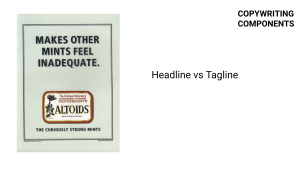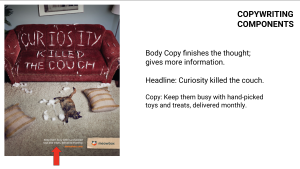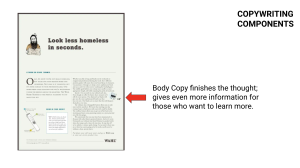Food For Thought
- There are three basic components of copywriting
- Copywriting components have a communications hierarchy
- There’s a storytelling structure
Few, if any, of my beginning copywriting students know that there are three basic components of Copywriting:
- Headline
- Tagline
- Body Copy
While the consumer could care less which is which, as a copywriter, you need to know. You also need to know how the components can work together to become more than the sum of the parts to create a message, a story, and an action. And that these components– the headline, tagline, and body copy– should be arranged appropriately in a communications hierarchy.
Let’s break the components down. The ad below has a headline, a subhead/body copy line, and a tagline. Which is which?

Which is the headline, subhead, and tagline? The copy components of the ad are:
- Headline: We’ve been protecting people since 1929
- Subhead: Now it’s your turn.
- Tagline: #stayhome
Together, these components tell a story. And the story they’re telling is that if you’ve got to be trapped together during quarantine, you might as well have a good time. But if you’re not ready to have a baby as a result of your indoor activities, you should protect yourself from unwanted parenthood by using a Durex condom.
Notice the arrangement of the three pieces of copy. The headline is biggest and most prominent, which makes you want to read it first. The subhead comes right after the headline and finishes the thought of the headline. The tagline/hashtag comes last and is paired with the logo. This hierarchy isn’t a coincidence. In any piece of communication, it’s not just what’s said but how it appears that matters.
So I pointed out the headline, subhead, and tagline/hashtag. But what if they’re not arranged in such an obvious way. How do you know one from the other?
A headline is the main thought.
A headline is an on-strategy way of sharing your message with the consumer. It’s usually the main line of text in an ad; the most important thing you read. But what goes underneath can have just as much of an impact. The headline should create synergy with the visual and usually varies from ad to ad. There are dozens of headline types, from headlines that are a question to headlines that are based on a metaphor, to ironic headlines, hyperbolic headlines, paradoxical headlines etc. We’ll explore the many many types of headlines in a later chapter.
A subhead or body copy completes the main thought.
You don’t always use a subhead but when you do, it follows the headline and completes the thought. If there’s more that needs to be said to complete the thought or to provide additional detail, you need more copy. That’s body copy. It finishes the thought presented in the headline and is presented in a way that makes you want to read it after the headline. Good body copy grabs attention, is organized and gets to the point quickly. But it takes skill, dedication and practice to get right. Today, you often see body copy on websites or anywhere more detail is needed. The most common type of body copy we see these days is on social media posts in the form of captions.
A tagline distills the brand and/or idea.
A tagline is an enduring catchphrase that positions the product, the company or idea. It’s also called a slogan or theme line. A more modern way of thinking of a tagline is as a hashtag because it unifies the idea, distills the brand’s essence and stands the test of time. For example: Nike’s tagline: Just do it.
Let’s look at more examples of the components of Copywriting.
In this famous ad for Altoids, which is the headline and which is the tagline?

- Makes other mints feel inadequate is the headline.
- The curiously strong mints is the tagline.
Note that in this ad there is only a headline and a tagline – no body copy. Not every ad includes body copy. This ad doesn’t need it to get its point across.
Here are three more Altoids ads that are part of a long-running campaign. Notice that the headline changes in each ad but the tagline “The Curiously Strong Mints” stays the same. The visuals are all different but have a similar look and tone. Each headline has “synergy” with the visual it’s paired with. We’ll discuss what “synergy” means later but for now, just think of it as the different components of the ad working together to create a meaning together they could not create individually.

Let’s move on from Altoids. Here’s an ad for cat owners whose furniture is their pet’s favorite scratching post. Notice there is a headline (scratched into the couch). There’s body copy. But there is no tagline. Just a logo and url. Not all brands have taglines.

Here’s what’s called a “long copy” ad. It has a headline followed by many, many words – each of which was carefully chosen – to tell you exactly how the Wahl beard trimmer does its job. Once again, there is no tagline.

The structure of storytelling
So now you know the three basic components of copywriting. Headline, tagline and body copy/subhead and you know that they’re written and placed in a hierarchical, ordered way so you know what to read first, second, and last. This helps the reader/consumer know to start at the beginning and read through the middle to the end.
The structure of storytelling matters. But before you decide how to tell the story, you need to know what story you want to tell. What’s the idea behind the story? In this course, you’ll learn how to come with an idea, describe an idea, and shape that idea into a convincing story.
You’ll learn to write better stories and be a better storyteller; by using the components of copywriting to persuade, invite, and connect.
Key Takeaways
Copywriting “samples” popular culture but has nothing to do with laws regulating who owns the art, music, etc. used to express popular culture.
Copywriting has three basic components: Headline, subhead or body copy, and tagline.
Headlines change; a tagline remains the same across all ads.
The order of the components matters.
Reminder: Copywriting is writing that persuades, invites, connects, and sometimes sells. In this course, you’ll learn how to choose each word carefully for maximum impact. You’ll learn to explain yourself & your ideas to others in a way they can relate to.
